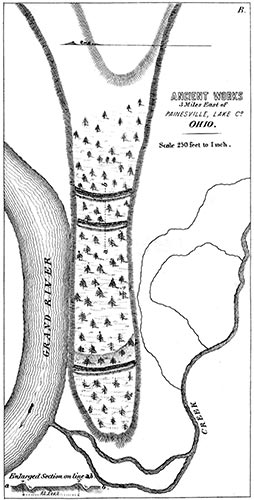PLATE VII. Fig. B.
THREE MILES AND A HALF EAST OF PAINESVILLE, LAKE COUNTY, OHIO.
This drawing represents a "stronghold" admirably situated for security and resistance. A long, narrow, natural wall of slate, or shale rock, is left standing between the creek and the river; its direction east and west; its elevation above the water is from eighty to ninety feet; and its faces as nearly perpendicular as the soft shale will allow. Except at the western extremity, a person might leap from the top to the bottom; though it is so steep as to be absolutely inaccessible, without ropes or bushes, or something by which to drag one's self up. The decomposing shale, or "soapstone," is very slippery, forming a greasy clay, always wet. The distance is two hundred and thirty feet from the point A to the first parallel, which is low, being only one and a half to two feet above the natural surface; its ditch about one foot deep, but like all the walls and ditches it varies at different points. Just in rear of this wall the ground rises gently four or five feet, and thence the plateau is nearly level for four hundred feet to the next parallel, and as far as a rise of land about three hundred feet to the east, where the promontory joins the main land. On each side back of the parallels are low bottom lands; but from thence forward to the point on the north is a water-washed bluff, and on the south a flat, through which the creek wanders very irregularly. The Grand River is about two chains wide, but fordable in ordinary stages. Over the whole promontory is a thick growth of hemlock, causing a perpetual shade within the area of the work.
The outer parallels at B are much stronger and better defined than the others, ranging from eight to ten feet in height from the bottom of the ditch. They are not straight or parallel, but irregular in direction as well as height, and are remarkably well preserved. There is an appearance of slight openings, but I think them due to travel in more recent times, wearing down the walls where they are crossed by paths; for although there is no road through the works, there are very old paths and trails, used not only by visitors, but by cattle running at large in the woods. This work appears upon the whole to have been without apertures, being in this respect like the one at Weymouth, Medina County, where the entrance of the occupants was probably by temporary wood work over the walls.
In a direct line, this work is about three miles from Lake Erie. The outer parallels are from fifteen to eighteen feet broad at the base, and from four to four and a half feet high, as shown in the section a, b.

